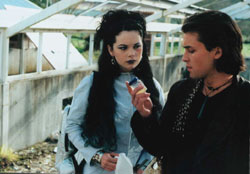 This week we take a look at the similarities between health matters from a sample of ancient times and compare life then to life in the world of The Tribe.
This week we take a look at the similarities between health matters from a sample of ancient times and compare life then to life in the world of The Tribe.
ANCIENT EGYPT
It is said that the ancient Egyptians were among the first people to have practicing physicians. They are male nurses, masseurs and lay therapists but no females.
Papyrus texts from 1700bc show that there was a fair understanding of illness and several recommended remedies. It is said that one of the earliest physicians was a man called Imhotep who was around in 2725bc.
The Egyptians firmly believed that in order to lead a healthy life people should keep themselves clean and avoid eating ‘unclean’ animals and fish.
Most homes of the gentry contained bathrooms. Other people would wash in the waters of the Great River Nile. People were responsible for getting rid of household rubbish at the communal dump (these dumps were consequently breeding grounds for disease).
This ancient race knew a lot about the human body, most probably due to the practice of embalming and mummification.
Health care came in the form of dream analysis, surgery, magic potions and rituals. Several natural remedies were used for treatment. Two such examples are: –
The tannic acid found in Acacia trees was said to heal burns. Coriander was used for stomach treatments.
Illness in those days was treated with these herbal remedies and physicians had a good basic knowledge of certain conditions, particularly wounds as there were many battles fought in those days. Internal or hidden problems were believed to be the work of gods or due to the ‘evil eye’ curse of a neighbour and were ‘treated’ with magic and prayers.
Some autopsies on mummies showed lung disease caused most probably from coal dust fires and the fine desert sand.
ROMAN LIFE
The Romans took health care very seriously and built aqueducts to transport fresh water into cities and towns. There were sewers built to take the waste back out of the cities.
Public toilets and baths were established. Swamps and marshes were drained to get rid of any infections loitering in their waters.
Local doctors could be visited although the poorer people might not have been able to afford this. There were state-funded hospitals set up for the masses. Herbal potions could be bought at the local markets.
There were diseases and infections but because of the standard of hygiene, life was not too bad.
 MEDIEVAL EUROPE
MEDIEVAL EUROPE
Living conditions were very poor in these ages. Several groups of houses shared a cess- pit between them. This was basically just a big hole in the ground that people used as a toilet. These cesspits were often located side by side and the risk of infections spreading from one to the other was high. Once the cesspits were full, the waste would slop out over the sides and down the streets, spreading any infection along the way.
Butchers and traders would throw scraps in to the street and everyone would dump their general rubbish in the road as well, where it was left to rot and fester.
Conditions improved somewhat in 1347-9 after the Black Death struck. Infected rats and fleas spread this plague and it was a horrible death.
Teams of muck collectors were employed to scour the streets of London and get rid of any waste and excrement. This was because people would empty their chamber pots out of the windows and on to the streets. Luckily this practice was deemed illegal in 1372. In fact a Master John de Pulteneye and a Master Thomas at Whytte were fined for building toilets that stuck out over the streets and emptying their contents directly on to them (or on to the heads of unsuspecting passersby!)
Lots of infections and diseases spreads like wildfire in these unhygienic conditions and Cholera and Typhoid were rife.
These medieval people believed in the supernatural as well as elves and goblins and most of their health care reflected this. Magic spells and potions were used as well as herbal remedies, ground up earthworms, urine and animal excrement. There was no cure however for the Black Death.
This was a plague that lasted from 1346-1350 and spread through Asia, Italy, France, North Africa, Spain, Normandy, Switzerland, Hungary, England, Scotland, Ireland, Norway, Sweden, Denmark, Iceland and Greenland.
The Medieval chronicler Frossiart states that a third of the world died from this terrible disease. That equates to approximately 20 million people.
Symptoms
The Black Death typically killed people between the third and fifth days of suffering. People would get a tingling sensation that would be followed by the development of a solid hard boil under the armpit or in the groin. This would swell and would cause a high fever with severe headaches.
Patients would sometimes cough up blood or develop septicemia (blood poisoning). The disease would basically ‘explode’ out of every pore of the patient. The smell from the sweat, spittle, urine and excrement was foul. Combine this with the smell of the decomposing corpses and imagine how terrible the stench would have been!
VICTORIAN ENGLAND
Life in Victorian England was not the healthiest. Most people were living in poor conditions. Only the very rich could afford to buy new houses that were elevated. The waste and sewerage would travel down from these homes directly to the poorer communities.
There were no toilets and no sewage pipes. All the human waste would pool on the streets and the rivers would become full of the stuff.
People had to get their water for washing and drinking from these rivers and many infections were passed on because of this. There were no baths and water was typically shared by 20 or 30 families from just one water pump.
There were many fatal infections and diseases that were spread such as dysentery, typhoid, cholera, smallpox, diphtheria, influenza, scarlet fever, measles and whooping cough.
A great many people died in this era and life expectancy in 1841 ranged from 26 years to 45 years, depending on which area the person lived in. The life expectancy of labourers and servants was 15 years.
There was an epidemic of both measles and whooping cough between 1838-1840 and 50,000 people died as a result.
Many people developed food poisoning because of the lack of understanding of the importance of hygiene. Rancid butter and diseased meat were the norm and some poisons were added to food to make it more desirable.
There were many deaths caused by working in unsafe environments. Builders and factory workers developed lung disease from constantly breathing in dust.
There was very little medical help available and only the rich could afford to seek it.
THE UNITED STATES OF AMERICA IN 1900.
There was no electricity in these times and bathing was still not considered a necessary ritual. There was no electricity. Penicillin had not yet been invented.
Tuberculosis and polio were the biggest killers and the average life expectancy was 46 for white American males and 32 for Black American males.
Women’s clothing was tight and constricting and was the cause of fainting episodes.
There were doctors, hospitals and some medicines but it would still be a long time before the poorer classes could have access to this kind of health care.
 TRIBAL HEALTH
TRIBAL HEALTH
It seems that the lives of the various tribes would revert back to life in ancient times. Life expectancy might drop to a low age and certain diseases might rear their ugly heads again.
Without sewerage pumping stations and chemicals being added to the water, disease could start to spread very quickly. There might be more rats and other vermin around that would carry disease whilst they scavenge for food.
The distinct lack of proper food would have to play a big part in the health of these people. Some of the food on offer might be contaminated or
And without the necessary immunisations other infections and diseases might take hold again.
There is no heating and this could affect the health of these people, particularly those who suffer from asthma.
There are some people to help with health care. Tai San is in to physical and spiritual well being. She is always brewing up herbal potions and consulting her crystals. Meditation takes up a lot of her time. She would be a good person to approach if there were sickness around although some people might not enjoy her kind of health care. Pride is very much involved in living off the land and knows a lot about the natural properties of herbs.

